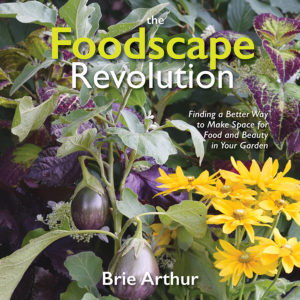Book Review: “The Foodscape Revolution”

The Foodscape Revolution by Brie Arthur (St. Lynn’s Press, 2017, 189 pp., $21.95)
I’m always excited when a book comes along that explains how a homeowner can have both an attractive landscape and a productive food garden at the same time. In Brie Arthur’s new book, The Foodscape Revolution, she does exactly that. Now it’s time to get the word out to folks who think they don’t have room for an edible garden. Or perhaps are worried what their neighbors will think of it.
As Arthur writes, “The average suburban foundation landscape — the foundation around the house — offers open space the equivalent of 1,250 sq. ft., or 48 average-sized 4×8 raised beds. That’s a lot of edible potential!”
She goes on to explain how “the ultimate aim of foodscape design is to make the most of the cultivated land while utilizing the existing shrub and turf base.”
In part one (“The Model”), each chapter sets the groundwork for Arthur’s game plan.
“Anatomy of a Foodscape” details the three foodscape growing zones, based on their proximity to the house. It’s essentially a ratio of ornamentals to edibles. She includes suggested plants for each zone. For example, in growing zone 3, she lists fruit and nut trees, Mexican sunflowers, corn, and mustard greens.
The following chapter looks at ornamental plants. She discusses the importance of assessing what you already have. Then adding diversity to the landscape rather than having a monoculture of the same plant family. The author recommends writing down your goals and starting with trees and shrubs as structure for your beds. Then add in annuals for color although she also gives some easy-care perennial plant suggestions.
Arthur advises having a soil test done before beginning any new landscape work. At that point, start with soil prep and diagramming your new beds. She even covers how to plant trees and shrubs so they’ll grow their best.
In “Just Add Edibles,” the author suggests edible plants for specific uses within the landscape. And that’s in addition to their culinary uses. These include using them as borders, groundcovers, those needing support, and as accents (i.e., corn, oats, wheat, kale, basil, Swiss chard and eggplant. Arthur emphasizes planting each crop at the right time for the best success.
She includes seed-planting methods and suggests which one to use for each crop.
In “What to Plant: Veggies and Herbs,” she outlines how and when to plant, what to harvest, and how to use them in cooking. She even covers what they contribute to a landscape.
There’s another chapter on growing fruits, nuts, berries and grains which includes general growing information. Unlike a lot of garden books, Arthur provides details on growing grains. These include amaranth, barley, buckwheat, oats, rice, rye, sesame, sorghum and wheat. She feels grains are an important part of our diet. As a bonus, the plants make attractive additions to the landscape as well.
The chapter on basic care and maintenance of a foodscape covers soil testing, using organic fertilizer at planting time, when and how to water, staking, weeding, controlling pests and diseases, and addressing cultural issues (ones caused by something we are doing such as overwatering). Brie Arthur has a pleasing, conversational writing style. She is honest about which aspects of foodscaping take some effort.
In part two of the book, the author has a fun collection of foodscaping projects such as a “foodie fire pit” within a garden room, a property screen meadow, edible neighborhood entryway, patio pots (planting edibles in containers), and alternative growing systems such as aeroponics, aquaponics and hydroponics.
Part three, “Yard to Table,” details harvesting, processing and preserving one’s bounty. This includes the timing for fruit-producing crops, leafy greens, root crops and grains. She covers the methods that are best for each type, whether it’s popping them directly into freezer containers, blanching before freezing, roasting and freezing, or storing them in dry form.
Arthur even shares her recipes and tips for using veggies. Examples include heirloom tomato juice, tomato paste, pizza sauce, spaghetti sauce, and candied jalapeno peppers.
In summing up her ideas, she states, “Next time you are tending your landscape, ask yourself, ‘Why can’t I have it all?’ Then consider the possibilities that a foodscape offers: a beautiful collection of plants, abundant flowers, a healthy ecosystem — and fresh produce! The logical integration of edibles in traditional landscapes makes too much sense to ignore.”
I believe Brie Arthur’s The Foodscape Revolution will be very inspiring for folks who want a yard that sustains them — both physically and spiritually — while keeping their neighbors and/or homeowners associations happy!

